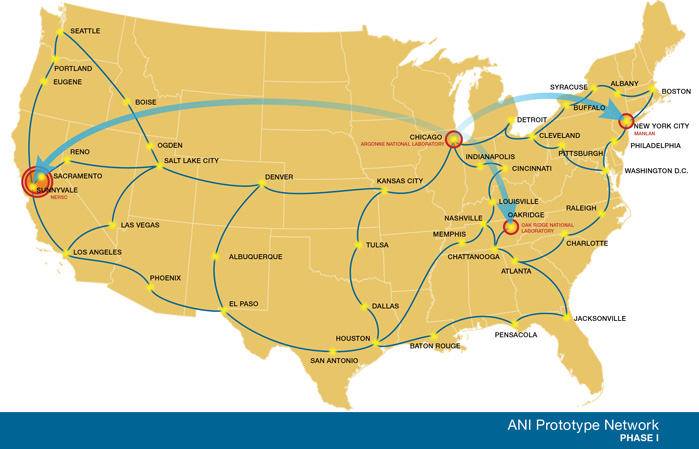100Gbps Science Network
Berkeley Lab Lays Foundation for 100 Gbps Prototype Network
Funded by the Advanced Networking Initiative (ANI), a $62 million multi-year investment by the DOE Office of Science in next-generation technology to further U.S. research competitiveness, Berkeley Lab signed an agreement with research and education network Internet2 to build one of the world's fastest scientific networks - a 100 gigabit-per-second (100 Gbps) prototype network, including hardware and dark fiber.

Initially the network will connect the three DOE unclassified supercomputing centers: the National Energy Research Scientific Computing Center (NERSC) at Berkeley Lab, Oak Ridge Leadership Computing Facility (OLCF), and Argonne Leadership Computing Facility (ALCF), as well as the Manhattan Landing International Exchange Point (MANLAN). These four sites are the first phase of a nationwide 100 Gbps scientific network that will support thousands of DOE scientists in their research, and a key step toward DOE's vision of a 1 terabit network connecting its exascale supercomputers and other forefront scientific user facilities.
The Energy Sciences Network (ESnet) staff will work with Internet2 to develop the prototype network, increasing the information-carrying capacity of DOE's present scientific network by several orders of magnitude. Part of the funding also went to develop a national-scale network testbed for researchers and industry to experiment with new network technologies, protocols and applications.
Networks like ESnet are ramping up capacity as the volume of data generated by scientific research rises exponentially. The ANI network will also jump-start ESnet's research in support of "green" energy-efficient networking - a hot priority as network and supercomputing center energy demands keep rising with data volumes. For more information, see the following links:




